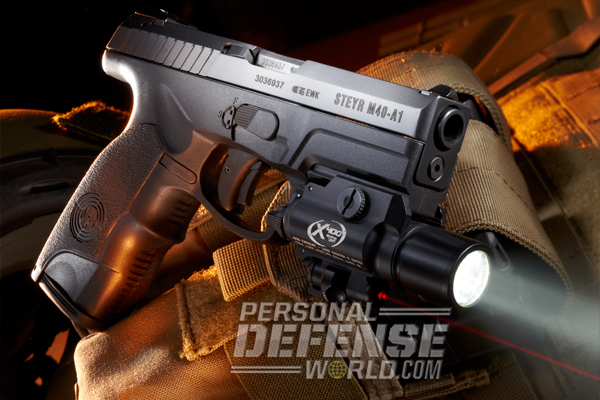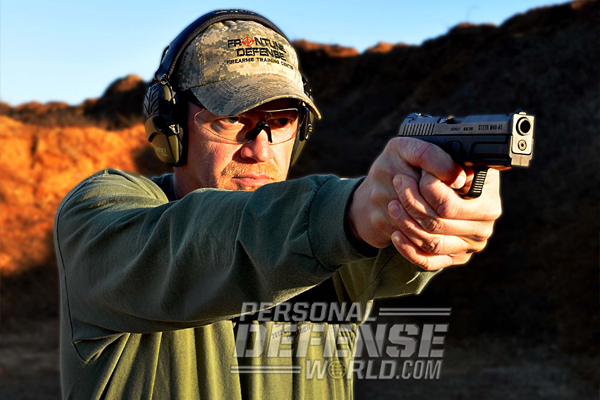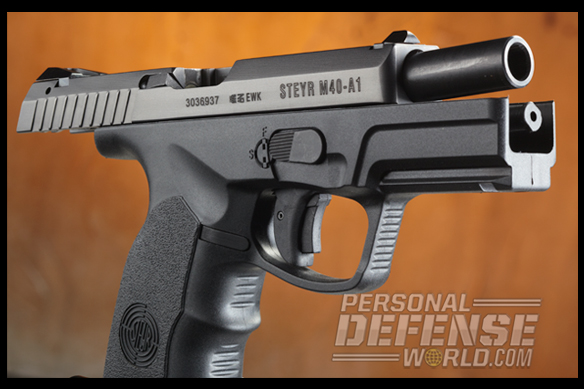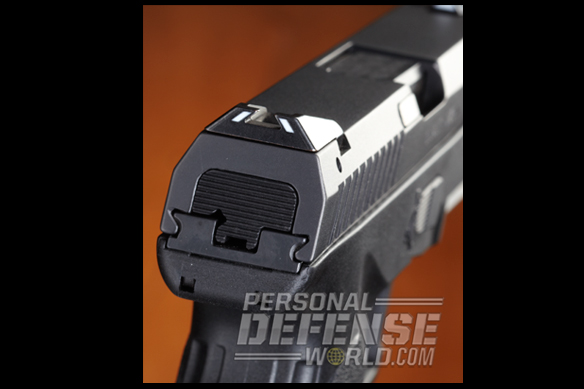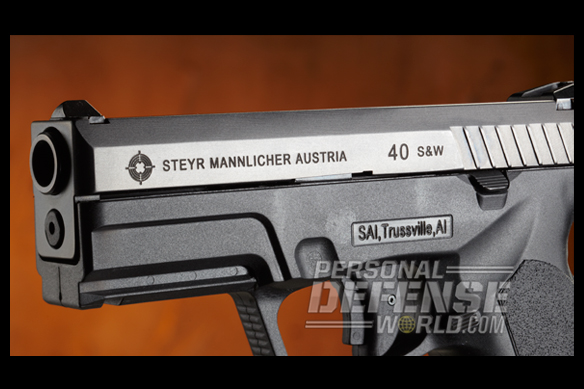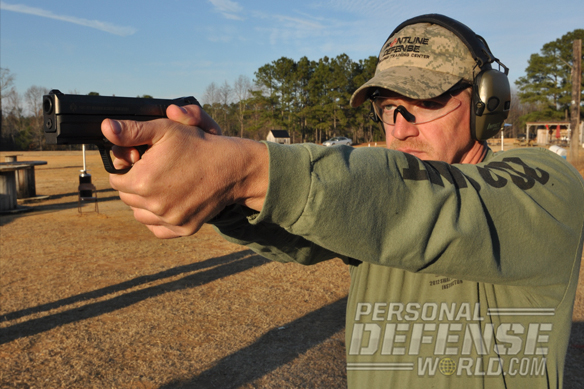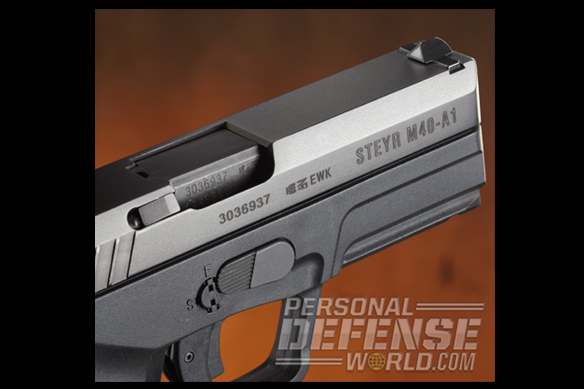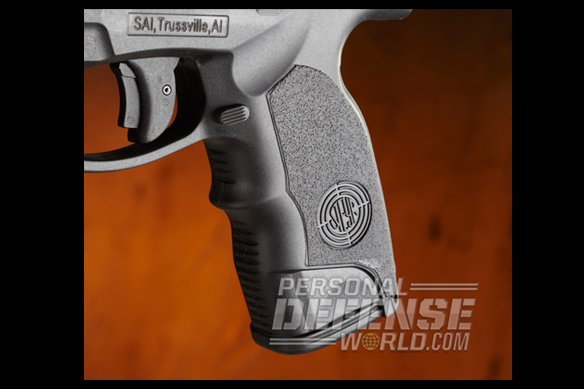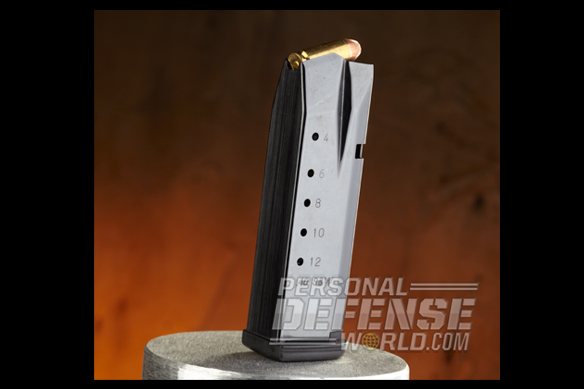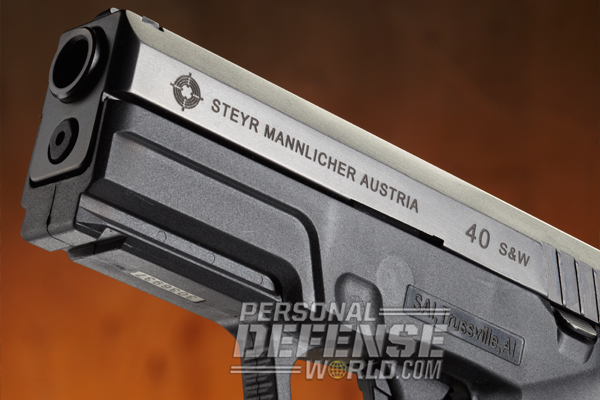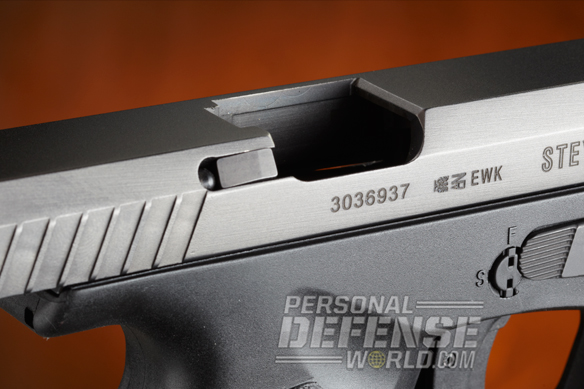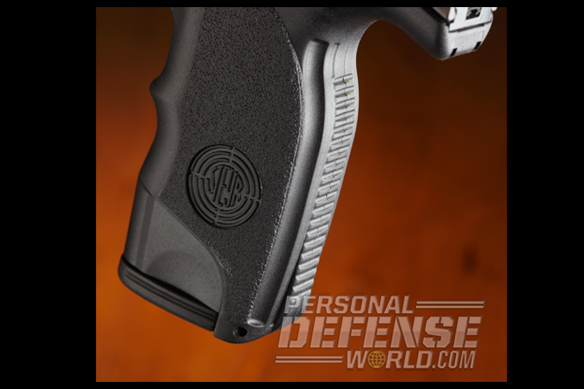Recently, I was fortunate enough to be able to receive and write about a pistol that I had heard about for a while but hadn’t had a chance to handle until this opportunity presented itself. My editor located a Steyr M-A1 pistol chambered in .40 S&W (an M40-A1) and asked me if I was interested in doing a piece on the gun. Needless to say, I jumped at the chance, and quick as a wink I had one of Steyr’s fine pistols at my doorstep. One reason I wanted to get my hands on an M-A1 was that it looks really cool. Another was just personal and professional curiosity about Steyr’s take on the polymer-framed pistol craze of the new millennium. Steyr has an exceptional reputation for making long guns, and after handling this pistol, I remain completely satisfied with its polymer pistol line—as represented by the M40-A1.
When the trigger reset, this gun really began to shine! Folks, there is hardly any take-up on the reset, and it is nice and fast!
When the trigger reset, this gun really began to shine! Folks, there is hardly any take-up on the reset, and it is nice and fast!
GUN DETAILS:
I got the pistol in and opened the all-black polymer case. Inside was the pistol, two magazines and various other items that come with the handgun, including the manual, paperwork, two locks and a couple of keys used to unlock the manual safety child lock on the right side of the pistol. I looked at the M40-A1 before picking it up and was again impressed with the pistol’s aesthetics. The thing is just cool to look at. I remember when the Steyr AUG was the bullpup to have due to its design, and I can see this pistol filling that same bill in the handgun arena. I then picked the pistol up and began my inspection.
Advertisement — Continue Reading Below
The Steyr M40-A1 is a striker-fired, polymer-framed .40-caliber semi-auto with a completely steel slide assembly. It uses the Browning short-recoil method of operation with what is called a linkless design, but it actually does have a partial link attached to the bottom of the barrel. It has an external extractor, and the grip is one of the most comfortable I’ve handled in a while. The bore axis is nice and low, and the pistol points perfectly. The pistol also has a paddle-type safety on the front of the trigger, like so many others of the genre today. The company calls its finish on these pistols Mannox-coated. The two included magazines are constructed of steel, and each holds 12 rounds of .40-caliber ammunition. The two biggest things that I noticed upon initial inspection were the sights and the rail under the slide. The sights are triangular and trapezoidal, and the accessory rail is a nice added feature.
CLICK HERE to read about and watch the video of the Steyr Arms L9-A1 Pistol & AUG M1 Rifle!
The slide of the pistol is marked “Steyr Mannlicher, Austria,” but the frame has the markings of “SAI, Trussville, AL,” which is the importer for this pistol. The last two features I noted and liked were the loaded-chamber indicator and the really comfortable finger grooves in the grip’s front strap. What makes the grip so great is a combination of things. The factors are reduced circumference, the high tang at the top of the backstrap, the angle of the grip, and the extended portion at the bottom of the backstrap, which serves two purposes—it is a small magazine well, aiding in inserting a new magazine rapidly, and it has a hole for a lanyard attachment.
Advertisement — Continue Reading Below
The rounded triggerguard is still large enough to accommodate someone wearing gloves, and, as I said earlier, the grip angle is one of the most comfortable I have felt in a while. Weight is 27 ounces unloaded, which is mostly due to the polymer frame and construction. Taking the gun apart and inspecting it before shooting revealed no surprises, save for how simple disassembly was on this excellent handgun. The pistol comes apart in a manner similar to other polymer-framed pistols, but with a few exceptions. The user first makes sure the pistol is clear, points it in a safe direction and dry fires the pistol. Built into the safety-lock feature on the right side of the pistol is a spring-loaded takedown lever that gets pushed in while rotating the takedown lever toward the floor—and that’s it! The entire upper now slides off the front of the gun, and you begin taking those sub-assemblies apart from there. The recoil spring and guide rod are one unit and encapsulated. Then the forged steel barrel (with partial fixed lug) comes out of the slide. One feature that I love is that the takedown lever rotates back up on its own when the slide is replaced properly and pulled to the rear. Traditionally, when reassembling pistols with a rotating takedown lever, the user is required to put the lever back in place manually, but that is not the case here.
Advertisement — Continue Reading Below
Now, the two main things that I was intrigued about on the Steyr M40-A1 deserve a little more detailed description: These are the trapezoidal sights and the grip angle. First, these sights are way different than standard notch and post, but that is not to say that is a bad thing—it just took some getting used to. After a small amount of practice, I found them to be quite fast and easy to pick up. Second, this grip design is one of the best I have felt in a polymer-framed (or any other) pistol, period. The grip is smaller in diameter than those on a lot of competitors’ pistols, and it has a nice high-grip recess in the tang of the pistol that reduces felt recoil much better than I expected. In short, it made this .40 caliber pistol shoot like a 9mm.
RANGE TIME:
I reassembled the Steyr and got this pistol to the range to try it out. For the accuracy and reliability testing I used Winchester 165-grain full metal jacket (FMJ), Speer Lawman 180-grain FMJ and Federal American Eagle 180-grain FMJ ammunition. The total round count was only about 150 rounds of ammo, which isn’t a huge amount, but I still experienced no malfunctions. That should indicate that the gun is going to work when (or if) needed.
Now, .40 S&W usually has a little sharper recoil than 9mm, but, on the M40-A1, the recoil was mild and easily managed no matter what ammo was being used. Handling and ergonomics were great, and all the controls were easy to manipulate. The Steyr pistol’s magazine-release button is located in the traditional spot, just behind the triggerguard on the left side of the pistol, and it is a small, horizontal-shaped button. It is steel, just like the magazines, and is recessed just the right amount to avoid accidental activation yet remain accessible. The trigger broke at a clean 5.1 pounds according to my Lyman digital trigger-pull gauge. The trigger pull was short, smooth and lacked any sticking at any point. When the trigger reset, this gun really began to shine! Folks, there is hardly any take-up on the reset, and it is nice and fast! Following the fundamentals of taking out the trigger slack, a slow steady press and follow through made for a nice, accurate shot. However, it is after that first shot that you realize you are holding a different polymer pistol in your hand. I began to slowly allow the trigger to reset, and when immediately heard and felt a positive click, I knew the gun was ready for the next shot. As soon as I began to press again, the next shot broke cleanly. I am impressed with the job Steyr has done on their trigger for the M40-A1.
Advertisement — Continue Reading Below
All of the shooting I did for the accuracy testing on the M40-A1 was from the 25-yard line in a benchrest position. All groups consisted of five consecutive shots at individual targets. The Winchester 165-grain had the most accurate grouping, with a printing of exactly 3 inches for a five-shot group. The Speer was next with its 180-grain FMJ printing at 3.25 inches for its five-shot group, and Federal American Eagle 180-grain FMJ was third in line, printing a 4.5-inch group. I noticed an interesting phenomenon that I either haven’t seen before or have utterly forgotten about. The very first shot I fired, regardless of ammo, was every time separate from the rest of the group. I don’t know if that is a result of the first round being hand-cycled and the others not, or if it was just me, but it still interested me. I also was intrigued by the fact that the most accurate group had two distinct two-shot groups whose holes were actually touching each other, aside from the first round fired. Again, I’m not sure what that means, if anything, but it did give me pause when I saw it.
FINAL THOUGHTS:
As it happened, I had this pistol in my possession considerably longer than is usual with a test gun. I admit to having a bit of pre-conceived notions about the pistol due to its being a relatively inexpensive handgun. Mark it down if you want, but I was wrong to think that this pistol might be any less than stellar simply because it doesn’t cost as much as some others. For an affordable price, the customer can have an accurate, reliable pistol not only for concealed carry, but also for home defense or competitive shooting. The factory trigger is more than acceptable to the buyer right out of the box and can easily be mastered with a minimum amount of practice. If you are looking for an affordable, new-millennium handgun based on a time-proven design, I think you will be pleased with the Steyr M40-A1!
For more information on the Steyr M40-A1 .40 Handgun, visit steyrarms.com.
Advertisement — Continue Reading Below
